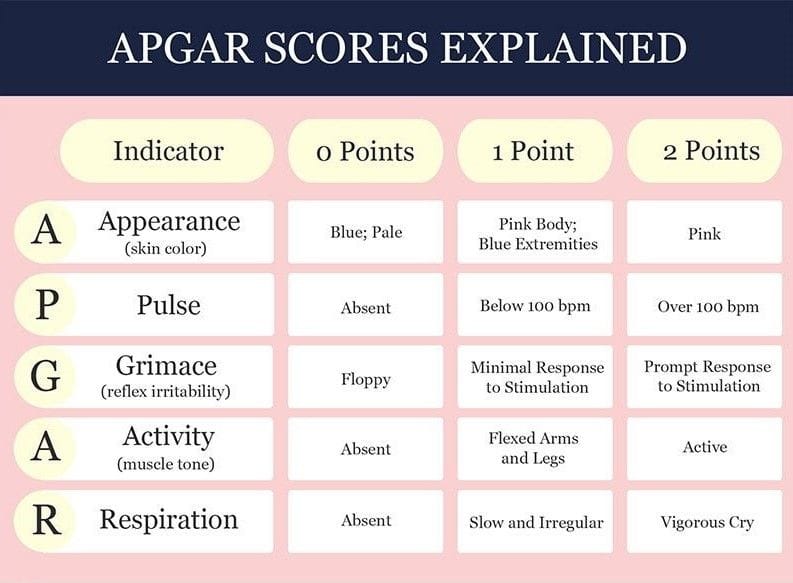If you are a first-time mother, you will see the medical staff (Doctors, Nurses, Mid Wives) surround your newborn and perform various tests on your baby. If this is not the first delivery that is not a new experience for you. But this is the first delivery you will be afraid to see your newborn that way. So, this article is about that test performed by medical staff immediately after your little one is born. This is called as Apgar score test.
What is the Apgar score test?
This is the first test of your baby’s life. The test will check your baby’s response to the world outside the womb. This Apgar score provides an accepted and convenient method for reporting the status of the newborn infant immediately after birth. This scoring system was devised by Dr. Virginia Apgar in 1952.
Apgar stands for?
A - Appearance (Skin color)
B - Pulse (Heart rate)
C - Grimace (Reflexes)
D - Activity (Muscle tone)
E - Respiration (Breathing rate and effort)
Apgar score chart

How test performed?
The test is performed by a doctor, midwife, or nurse. In this test above mentioned each category is scored on a scale of 0 to 2 with 2 being the best score.
Appearance
Medical staff will look at your baby’s skin tone or color. Oxygen-rich blood is what makes babies turn from a bluish tone to a more pink color. After taking a first breath, the baby starts circulating oxygen-rich blood.
Pulse
A doctor uses a stethoscope to examine the baby’s heart rate.
Grimace
This will examine the baby’s reaction to stimulation. This can check by suctioning your baby’s nose or mouth.
Activity
Medical staff will look at the amount of movement in your baby’s arms and legs.
Respiration
This is determined by how much and how loudly your baby cries.
Normal results
Using a scale from 1 to 10, the Apgar score is calculated. The baby is doing better after birth, as indicated by a higher score. A typical and healthy baby has a score of 7 or higher. A score of 10 is quite rare because usually babies lose 1 to 3 points for having blue hands and feet after birth, which is normal.
Abnormal results
Any score lower than 7 is a sign that the baby needs medical attention. But lower Apgar score does not mean a child will have serious or long-term health problems, as most of the time, a low score at 1 minute is near normal by 5 minutes.
Reasons for abnormal results
- High-risk pregnancy
- C-Section delivery
- Fluid in the baby’s airway
- Fetal heart rate monitoring errors
- Premature birth or preterm birth
- Maternal medical conditions
- Infections
- Placental abruption
- Prolonged labor
- Umbilical cord problems
- Uterine rupture
- Uterine hyperstimulation during induction of labor
Treatments for low Apgar score babies
- Physical stimulation to get the heartbeat normal
- Oxygen delivering through a mask
- Clearing of the airway
If the baby shows signs of distress, oxygen deprivation, or any other difficulties, they may be transferred to the Neonatal Intensive Care Unit (NICU) for more intensive medical attention and they’ll be watching the baby closely.
Limitations of Apgar scoring
- Apgar score is not developed to predict a baby’s long-term health
- The Apgar score can not be considered of Asphyxia on its own
- Human errors can be happened during using this system
So don’t panic as it is just a small assessment about your new born baby. And don’t get decisions about overall health of your baby based on these results.







